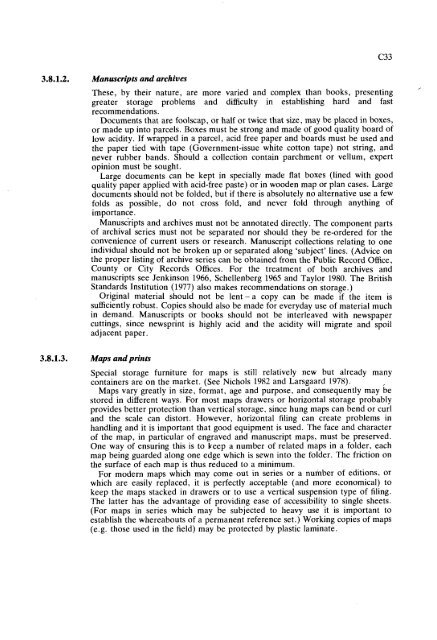GUIDELINES FOR THE CURATION OF GEOLOGICAL MATERIALS
GUIDELINES FOR THE CURATION OF GEOLOGICAL MATERIALS
GUIDELINES FOR THE CURATION OF GEOLOGICAL MATERIALS
Create successful ePaper yourself
Turn your PDF publications into a flip-book with our unique Google optimized e-Paper software.
3.8.1.2. Manuscripts and archives<br />
These, by their nature, are more varied and complex than books, presenting<br />
greater storage problems and difficulty in establishing hard and fast<br />
recommendations.<br />
Documents that are foolscap, or half or twice that size, may be placed in boxes,<br />
or made up into parcels. Boxes must be strong and made of good quality board of<br />
low acidity. If wrapped in a parcel, acid free paper and boards must be used and<br />
the paper tied with tape (Government-issue white cotton tape) not string, and<br />
never rubber bands. Should a collection contain parchment or vellum, expert<br />
opinion must be sought.<br />
Large documents can be kept in specially made flat boxes (lined with good<br />
quality paper applied with acid-free paste) or in wooden map or plan cases. Large<br />
documents should not be folded, but if there is absolutely no alternative use a few<br />
folds as possible, do not cross fold, and never fold through anything of<br />
importance.<br />
Manuscripts and archives must not be annotated directly. The component parts<br />
of archival series must not be separated nor should they be re-ordered for the<br />
convenience of current users or research. Manuscript collections relating to one<br />
individual should not be broken up or separated along 'subject' lines. (Advice on<br />
the proper listing of archive series can be obtained from the Public Record Office,<br />
County or City Records Offices. For the treatment of both archives and<br />
manuscripts see Jenkinson 1966, Schellenberg 1965 and Taylor 1980. The British<br />
Standards Institution (1977) also makes recommendations on storage.)<br />
Original material should not be lent - a copy can be made if the item is<br />
sufficiently robust. Copies should also be made for everyday use of material much<br />
in demand. Manuscripts or books should not be interleaved with newspaper<br />
cuttings, since newsprint is highly acid and the acidity will migrate and spoil<br />
adjacent paper.<br />
f<br />
3.8.1.3. Maps and prints<br />
Special storage furniture for maps is still relatively new but already many<br />
containers are on the market. (See Nichols 1982 and Larsgaard 1978).<br />
Maps vary greatly in size, format, age and purpose, and consequently may be<br />
stored in different ways. For most maps drawers or horizontal storage probably<br />
provides better protection than vertical storage, since hung maps can bend or curl<br />
and the scale can distort. However, horizontal filing can create problems in<br />
handling and it is important that good equipment is used. The face and character<br />
of the map, in particular of engraved and manuscript maps, must be preserved.<br />
One way of ensuring this is to keep a number of related maps in a folder, each<br />
map being guarded along one edge which is sewn into the folder. The friction on<br />
the surface of each map is thus reduced to a minimum.<br />
For modern maps which may come out in series or a number of editions, or<br />
which are easily replaced, it is perfectly acceptable (and more economical) to<br />
keep the maps stacked in drawers or to use a vertical suspension type of filing.<br />
The latter has the advantage of providing ease of accessibility to single sheets.<br />
(For maps in series which may be subjected to heavy use it is important to<br />
establish the whereabouts of a permanent reference set.) Working copies of maps<br />
(e.g. those used in the field) may be protected by plastic laminate.

















